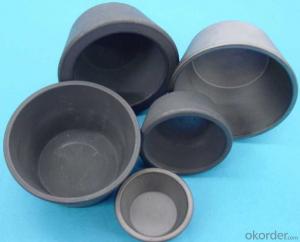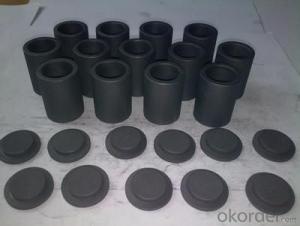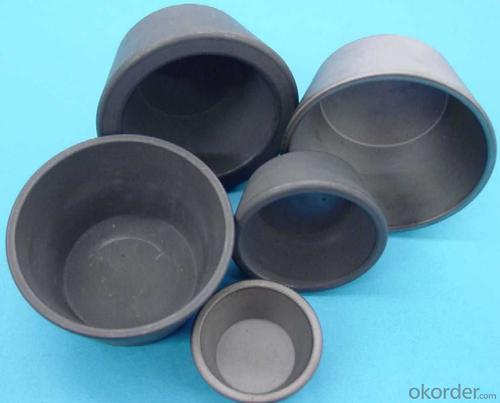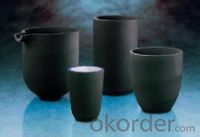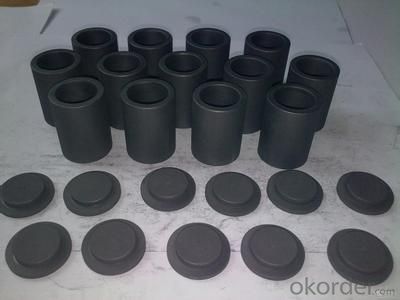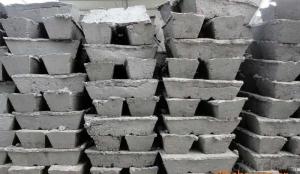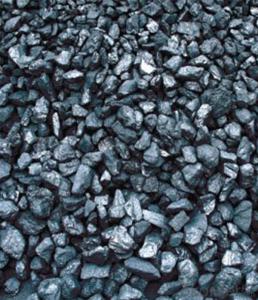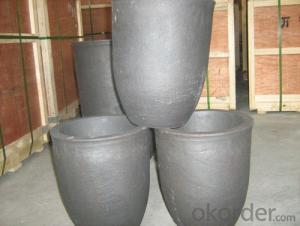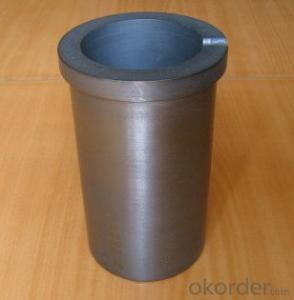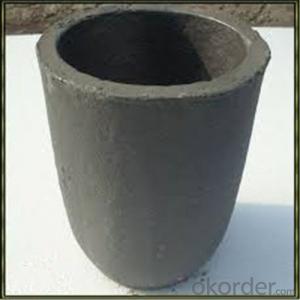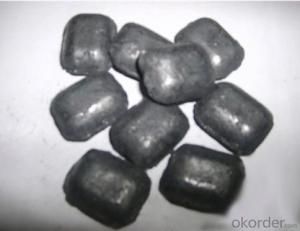Graphite Crucible/High Quality CNBM Graphite Crucibles
- Loading Port:
- China main port
- Payment Terms:
- TT OR LC
- Min Order Qty:
- 0 m.t.
- Supply Capability:
- 100000 m.t./month
OKorder Service Pledge
OKorder Financial Service
You Might Also Like
Specifications
1. SIC graphite crucible
2. high pure and density
3. high strength crucible
4. ISO 9001
5. high heat condduction
Product Description
A crucible is a container used to hold metal for melting in a furnace and it is needed to withstand the extreme temperatures encountered in melting metals. The crucible material must have a much higher melting point than that of the metal being melted and it must have good strength even when white hot.
Graphite crucible can withstand the high temperature, and has good resistance to chemical erosions and thermal shock. Especially graphite crucible is ideal for the melting of aluminum, copper and etc.
Specification
Bulk Density | g/cc | 1.70-1.88 |
Specific Resistance | μΩ.m | 6.0-15.0 |
Compressive Strength | MPa | 30-80 |
Bending Strength | MPa | 20-45 |
Shore hardness | 30-70 | |
C.T.E.(100-600°C) | x10-6 /°C | 2.5-5.5 |
Ash | % | 0.01-0.2 |
Maximum Grain Size | mm | 0.044-0 |
Usage
1. Graphite crucible cannot be exposed in moisture, and must be placed in indoor dry place or wooden shelf. Maintain ventilated. Moisture is strictly prohibited. Damped crucible is likely to crack.
2. Each crucible, especially damped ones, must be preheated and roasted in drying equipment or next to a ground furnace before use. The roasting temperature should start from a low temperature of 100°C below. Roast it to 150°C at a speed of not higher than 30°C per hour. Preserve the heat for about 8 hours and then dry it. The crucible dried next to a ground furnace should be placed at least for one shift, and often turned to change direction, till workers feel the internal wall of crucible is hot.
3. The melting time for the first time should be at least twice of the normal melting time, in order to avoid cracking inside the crucible due to heating up too fast, or even cracking immediately when the fire sets on.
4. Handle with care. Falling or shaking is strictly forbidden in order to present cracking. Crucible should be placed below the mouth of furnace to prevent the furnace lid abrading the upper edge of the crucible and thus affecting the capacity.
5. Pour out the remaining cold metals inside the crucible after use, and then add new materials. Carefully and gently add new materials into the crucible. Feed materials according to the capacity of crucible. It is not allowed to feed too many materials, in order to prevent crucible from swelling or bursting.
Picture

- Q: What are the advantages and disadvantages of carbon monoxide and carbon dioxide?
- Carbon monoxide is a common poison, but trace use is good for organ transplants. British researchers have recently developed a new method that can effectively use carbon monoxide to help transplant organs survive, while avoiding the risk of carbon monoxide poisoning. Excessive inhalation of carbon monoxide poisoning will lead to death, carbon monoxide into the human body, and soon the hemoglobin in blood combined with the formation of carboxyhemoglobin, causes red blood cells to reduce the oxygen carrying, the tissue hypoxia in vivo. The cardiac and central biblical system is the most sensitive to hypoxia and the earliest affected. In the air of carbon monoxide concentration reached 117 mg / M 3, people can feel headache, vertigo: up to 292.5 mg / M 3 symptoms; up to 582.5 mg / M 3 will be nausea and vomiting, exhaustion, if not timely rescue can have life risk. When the concentration of carbon monoxide in the air reaches 11700 mg / M 3, a coma occurs; the concentration of carbon monoxide in the air reaches 1170 mg / m. The 3 spoons will soon die. This is bad. But in organ transplant operations, the use of trace amounts of carbon monoxide helps dilate blood vessels and reduce inflammation, thereby increasing the survival rate of transplanted organs.
- Q: What is the role of carbonation in carbonated drinks?
- The purpose of carbonation in carbonated drinks is to give them their characteristic refreshing and bubbly sensation. Carbonation occurs when carbon dioxide gas is dissolved into a liquid, usually water, under pressure. This process produces carbonic acid, which adds a tangy taste to the drink. Carbonation serves multiple functions in carbonated beverages. Firstly, it enhances the flavor by creating a unique bubbly sensation that delights the taste buds and provides a refreshing feeling in the mouth. The effervescence resulting from carbonation also adds to the overall sensory experience, making the drink more enjoyable to consume. Additionally, carbonation acts as a natural preservative in carbonated drinks. The presence of carbon dioxide gas inhibits the growth of bacteria and other microorganisms, thus extending the shelf life of the beverage. This is especially important for soft drinks that are often stored for long periods before being consumed. Furthermore, carbonation plays a role in the presentation of carbonated drinks. The release of carbon dioxide gas creates bubbles and fizz, making the beverage visually appealing and enticing. This visual appeal is often associated with a sense of luxury and indulgence. In summary, carbonation is a vital element of carbonated drinks as it contributes to their taste, preservation, and visual appeal. It enhances the sensory experience and adds to the overall enjoyment of these beverages.
- Q: How does carbon affect food production?
- There are several ways in which carbon impacts food production. Firstly, carbon dioxide (CO2) plays a vital role in photosynthesis, the process by which plants convert sunlight into energy and produce oxygen. Insufficient levels of carbon dioxide hinder plant growth and food production. However, excessive carbon emissions from human activities, such as the burning of fossil fuels, have led to increased concentrations of CO2 in the atmosphere. Initially, this can stimulate plant growth, but without a proper balance of essential nutrients, it can result in nutrient imbalances and reduced crop quality. Secondly, carbon is a crucial element in soil organic matter, which is essential for soil fertility and health. Soil organic matter retains moisture, enhances soil structure, and provides a habitat for beneficial microorganisms. Higher carbon levels in the soil promote healthier plant growth, increase nutrient availability, and improve water-holding capacity. Unfortunately, unsustainable agricultural practices like excessive tilling and deforestation deplete soil carbon, leading to decreased fertility, erosion, and reduced food production. Moreover, the rise in carbon emissions has contributed to global climate change, resulting in extreme weather events such as droughts, floods, and heatwaves. These events have devastating consequences for food production. Droughts reduce water availability, making it difficult for crops to grow, while floods can wash away entire harvests. Heatwaves damage crops, reduce yields, and increase the prevalence of pests and diseases. Climate change also alters rainfall patterns, affecting planting and harvesting schedules and disrupting agricultural systems. Furthermore, carbon emissions contribute to the acidification of oceans. The increased CO2 in the atmosphere leads to higher levels of dissolved carbon dioxide in seawater, forming carbonic acid. This acidification disrupts marine ecosystems, affecting the food chain and impacting fish populations, which serve as a crucial protein source for many people. To mitigate the negative impacts of carbon on food production, it is essential to reduce carbon emissions and transition to more sustainable agricultural practices. This includes adopting climate-smart farming techniques like agroforestry, conservation agriculture, and organic farming. These practices promote carbon sequestration in soils, reduce greenhouse gas emissions, enhance biodiversity, and improve soil health. Additionally, investing in research and development of climate-resilient crop varieties and improved irrigation systems can help minimize the effects of climate change on food production.
- Q: How does carbon pricing work?
- Carbon pricing is an approach that utilizes the market to decrease greenhouse gas emissions by placing a value on carbon emissions. This is achieved by assigning a financial cost to the release of carbon dioxide and other greenhouse gases into the atmosphere, which greatly contribute to climate change. There exist two primary forms of carbon pricing mechanisms: carbon taxes and cap-and-trade systems. Under a carbon tax, a fixed price per metric ton of carbon emissions is established, and emitters are obligated to pay this tax according to their emissions. The tax can be imposed at different points in the supply chain, such as during extraction, production, or consumption. The goal of a carbon tax is to create a economic deterrent for emitting carbon and motivate industries and individuals to reduce their emissions. On the other hand, cap-and-trade systems impose a limit or cap on the total amount of carbon emissions permitted within a specific jurisdiction. This cap is divided into allowances, which represent the right to emit a particular amount of carbon. These allowances are either distributed or auctioned to emitters in the form of permits. Emitters can then trade these permits amongst themselves in a market. If an emitter surpasses their allocated allowances, they must purchase additional permits from those who have surplus allowances. This establishes a market-based incentive for emission reduction, as those who can more cost-effectively decrease their emissions can sell their excess allowances to those who are unable to. Both carbon taxes and cap-and-trade systems aim to incorporate the cost of carbon emissions into the economy, making pollution more expensive and encouraging the adoption of cleaner technologies and practices. By assigning a value to carbon, these mechanisms provide economic signals that urge businesses, industries, and individuals to invest in low-carbon alternatives, energy efficiency, and innovation. Additionally, they generate revenue for governments, which can be utilized to fund efforts in climate change mitigation and adaptation, renewable energy projects, or to reduce other taxes. Overall, carbon pricing mechanisms are designed to establish economic incentives for reducing greenhouse gas emissions, facilitating the transition to a low-carbon economy, and mitigating climate change. While they may not be a perfect solution, they are widely acknowledged as one of the most effective tools for driving emission reductions and combating climate change.
- Q: What are the consequences of increased carbon emissions on forest ecosystems?
- Forest ecosystems experience significant consequences due to the increase in carbon emissions. One of the most notable effects is the modification of climate and weather patterns. The excessive presence of carbon dioxide in the atmosphere results in the retention of heat, leading to global warming. This rise in temperature can disrupt the delicate equilibrium of forest ecosystems. The warmer temperatures can cause shifts in the distribution and composition of tree species, as some may struggle to adapt to the changing conditions. Another outcome of the rise in carbon emissions is the acidification of rainwater. When carbon dioxide combines with water vapor, it creates carbonic acid, which can fall as acid rain. Acid rain has detrimental impacts on forest ecosystems, as it extracts vital nutrients from the soil and damages tree leaves and other vegetation. This weakens the overall health of the forest and makes it more susceptible to diseases and pests. Moreover, increased carbon emissions contribute to the intensification of wildfires. Higher temperatures and drier conditions provide an ideal environment for fires to spread and occur more frequently. Forests that have evolved to withstand natural fire patterns may struggle to cope with the increased intensity and frequency of these fires. This can result in the loss of biodiversity, destruction of habitat, and long-term degradation of forest ecosystems. Lastly, increased carbon emissions contribute to the phenomenon known as ocean acidification, where excess carbon dioxide is absorbed by the oceans. This acidification can impact the well-being of coastal and marine ecosystems, which are intricately connected to forest ecosystems. Many forest ecosystems, such as mangroves and salt marshes, serve as important nursery habitats for marine species. If these forest ecosystems decline due to carbon emissions, it can have cascading effects on the health and productivity of coastal and marine ecosystems. Overall, the increase in carbon emissions has wide-ranging consequences on forest ecosystems. It alters climate patterns, causes acid rain, intensifies wildfires, and affects coastal and marine ecosystems. These impacts not only harm the trees and vegetation within the forests but also disrupt the delicate balance of the entire ecosystem, resulting in the loss of biodiversity and long-term degradation. It is crucial to mitigate carbon emissions and promote sustainable practices to minimize these consequences and preserve the health and integrity of forest ecosystems.
- Q: What is carbon steel, carbon manganese steel?
- Compared with other kinds of steel, carbon steel is the earliest, low cost, wide performance range and the largest amount. For nominal pressure PN is less than or equal to 32.0MPa, temperature of -30-425 water, steam, air, hydrogen, ammonia, nitrogen and petroleum products such as medium. Commonly used grades are WC1, WCB, ZG25 and high quality steel 20, 25, 30 and low-alloy structural steel 16Mn
- Q: What is carbon coffee fiber?
- The carbon coffee fiber uses the coffee residue left after the coffee and is made into crystal by calcining, then ground into nanometer powder and added to the polyester fiber to produce a functional polyester staple, a coffee carbon fiber.
- Q: What are the consequences of increased carbon emissions on indigenous communities?
- Indigenous communities are severely affected by the increased carbon emissions, with their traditional lands and natural resources degrading as one of the most immediate consequences. These emissions contribute to global warming, resulting in higher temperatures, altered weather patterns, and more frequent and intense natural disasters like hurricanes, droughts, and wildfires. These events can cause crop destruction, infrastructure damage, and the displacement of indigenous peoples from their ancestral territories. Furthermore, carbon emissions contribute to air pollution, which disproportionately affects indigenous communities living near industrial facilities and exposes them to higher levels of toxic pollutants. This exposure leads to respiratory illnesses, cardiovascular diseases, and other health problems, exacerbating existing health disparities. Climate change-induced loss of biodiversity also has an impact on indigenous communities, as they rely on traditional knowledge and practices for sustainable resource management. Changes in ecosystems disrupt the availability and abundance of food, water, and medicinal plants, undermining indigenous cultures and traditional livelihoods. Moreover, many indigenous communities heavily depend on natural resources such as fishing, hunting, and agriculture for economic development. However, with increased carbon emissions, these resources become scarcer and less reliable, posing economic challenges and creating financial insecurity for indigenous communities. In addition to the environmental and economic consequences, increased carbon emissions also contribute to the loss of cultural heritage and identity. Indigenous communities have a deep connection to their territories and the natural world, which is threatened by the impacts of climate change. This loss of cultural heritage not only negatively affects indigenous communities but also diminishes the diversity of human knowledge and perspectives, which is detrimental to humanity as a whole. In summary, the consequences of increased carbon emissions on indigenous communities are extensive and severe. They not only undermine their traditional lands, resources, and health but also erode their cultural heritage and identity. Recognizing and addressing these impacts is crucial to ensure the protection and well-being of indigenous communities and to mitigate the effects of climate change globally.
- Q: How is carbon dioxide released into the atmosphere?
- Carbon dioxide is released into the atmosphere through a variety of natural and human activities. One of the primary sources of carbon dioxide is the burning of fossil fuels such as coal, oil, and natural gas for energy production. When these fuels are burned, carbon dioxide is released as a byproduct of combustion. This happens in power plants, factories, and vehicles that rely on these fossil fuels for energy. Deforestation and land-use changes also contribute to the release of carbon dioxide into the atmosphere. Trees absorb carbon dioxide through photosynthesis, and when they are cut down or burned, the stored carbon is released back into the atmosphere. This is particularly significant in tropical rainforests, where large amounts of carbon are stored in vegetation. Additionally, natural processes such as respiration and volcanic eruptions release carbon dioxide into the atmosphere. Respiration is the process by which living organisms, including humans and animals, breathe in oxygen and exhale carbon dioxide as a waste product. Volcanic eruptions release carbon dioxide stored in magma and rock formations. Overall, the release of carbon dioxide into the atmosphere is a combination of both natural and human activities. However, human activities, particularly the burning of fossil fuels and deforestation, have significantly increased the levels of carbon dioxide in the atmosphere, leading to the greenhouse effect and climate change.
- Q: What are the different types of carbon-based concrete additives?
- There are several different types of carbon-based concrete additives, including carbon fibers, carbon nanotubes, and graphene.
Send your message to us
Graphite Crucible/High Quality CNBM Graphite Crucibles
- Loading Port:
- China main port
- Payment Terms:
- TT OR LC
- Min Order Qty:
- 0 m.t.
- Supply Capability:
- 100000 m.t./month
OKorder Service Pledge
OKorder Financial Service
Similar products
Hot products
Hot Searches
Related keywords
